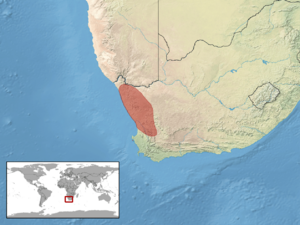Calvinia thick-toed gecko facts for kids
Quick facts for kids Pachydactylus labialis |
|
|---|---|
| Conservation status | |
| Scientific classification | |
| Genus: |
Pachydactylus
|
| Species: |
labialis
|
 |
|
| Synonyms | |
|
|
The Pachydactylus labialis, also known as the Calvinia thick-toed gecko, is a small lizard. It is a type of gecko that lives only in certain parts of South Africa. You can find these geckos in the Western Cape and Northern Cape provinces. They often hide under stones to stay safe and cool.
Contents
Where Does This Gecko Live?
This gecko lives only in the dry, western areas of South Africa. This means it is endemic to this region. One of its common names, the Calvinia thick-toed gecko, comes from the town of Calvinia. This town is located in the Namakwaland area.
What Does the Calvinia Gecko Look Like?
The Calvinia thick-toed gecko is quite small. Its body, from its snout (nose) to its vent (where its tail starts), is about 44 mm (1.7 in) long. Its tail adds another 38 mm (1.5 in) to its total length.
Head and Body Markings
The gecko's head is about 10 mm (0.39 in) long. It is a bit narrower than some other gecko species. From above, its body looks grayish-brown. It has dark, uneven markings and lighter spots. These spots are often arranged in stripes along its back.
A dark band runs from below its eye to above its ear. A lighter stripe goes from the tip of its snout, passing above this dark eye streak. The scales around its mouth, called labial scales, are dark brown and creamy white. This gives the gecko a cool striped-lip look!
Tail Appearance
If the gecko has its original tail, it will have dark brown to blackish stripes across it. However, if the gecko has regrown its tail (which they can do if they lose it), the new tail will usually have more spots instead of stripes.
Images for kids



